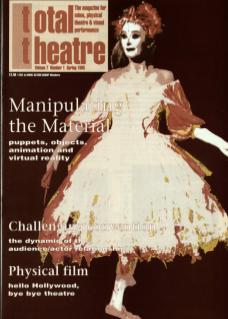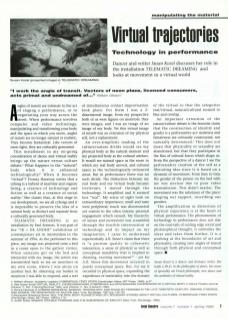'I work at the angle of transit. Vectors of neon plaza, licensed consumers, acts primal and undreamed of...' - William Gibson1
Angles of transit are intimate to the act of staging a performance, or to negotiating your way across the street. When performance involves computer and video technology, manipulating and transforming your body and the space in which you move, angles of transit are no longer natural or realistic. They become fantastical. Like vectors of neon light, they are culturally generated.
This installment in my ongoing consideration of dance and virtual reality brings up the nature versus culture debate.2 What happens to the ‘natural’ body when it is enhanced technologically? When it becomes ‘virtual’? Donna Haraway writes that a cyborg is a hybrid of machine and organic being, a creature of technology and fiction as well as a creature of social reality.3 She claims that, at this stage in our development, we are all cyborgs and it is impossible to preserve the idea of a natural body as distinct and separate from a culturally generated body.
Telematic Dreaming is an installation by Paul Sermon. It was part of the Ik + De Ander exhibition of contemporary art in Amsterdam in the summer of 1994. As the performer in this piece, my image was projected onto a bed in a room open to the gallery visitor. When someone got on the bed and interacted with my image, the action was transmitted back to me on monitors in my own room, where I was alone on another bed. By observing our bodies in monitors I was able to respond, and a sort of simultaneous contact improvisation took place. For them I was a two-dimensional image. From my perspective both of us were figures on monitors: they were images, and I was an image of an image of my body. Yet this virtual image of myself was an extension of my physical self, not a replacement.
An over-simplistic reading of the culture/nature divide would see my physical body as the natural element and my projected body as the cultural artefact. It would see natural space as the room in which my real body moved, and cultural space as the technologically enhanced areas. But in performance there was no such divide. The distinction between my real body and my virtual body became irrelevant, I moved through the technology. It amplified and it seemed less ‘real’. My sense of sight took on extraordinary importance; smell and taste were peripheral; touch was disconnected yet central to the often intense personal engagement which ensued. My hierarchy of senses and movement was scrambled through the forcible intervention of technology and its impact on my imagination. I came to understand experientially A.R. Stone's claim that there is ‘a protean quality to cybernetic interaction, a sense of physical as well as conceptual mutability that is implied in dizzying, exciting movement’4 – yet for A.R. Stone this movement occurred in purely conceptual space. But, for me, it occurred in physical space, expanding the expedience of materiality into the domain of the virtual so that the categories real/virtual, natural/cultural seemed to blur and overlap.
An important extension of the nature/culture debate is the feminist claim that the construction of identity and gender is a performative act: maleness and femaleness are culturally constructed, not naturally determined.5 This does not mean that physicality or sexuality are abandoned, but that they participate in the flux of cultural forces which shape us. From the perspective of a dancer I see the performative creation of the self as a liberating idea since it is based on a dynamic of movement. From time to time the gender of the person on the bed with me was unclear due to poor video transmission. This didn't matter. The movement was the substance of the piece: shaping our rapport, inscribing our genders.
The amplification or distortion of physical experience is at the heart of virtual performance. The phenomenon of technology in performance does not ride on the coat-tails of cutting edge social and philosophical thought, it embodies the ideas and takes them further. It is a pushing at the boundaries of art and physicality, creating new angles of transit through both physical and conceptual space.
Susan Kozel is a dancer and freelance writer. She holds a Ph.D. in the philosophy of dance. Her areas of speciality are French philosophy, new dance and the aesthetics of virtual reality.
1. William Gibson, Academy Leaders Cyberspace: First Steps (Cambridge, Mase: MIT Press, 1993), p.27.
2. See Susan Kozel, ‘Virtual Reality: Choreographing Cyberspace’ and ‘Spacemaking: Experiences of a Virtual Body’ in Dance Theatre Journal Volume 11, NO. 2 Spring/Summer 1994, and Volume 11, No. 3 Autumn 1994.
3. Donna Haraway, A Cyborg Manifesto: Science, Technology, and Socialist-feminism in the Late Twentieth Century, Simians, Cyborgs, and Women: The Reinvention of Nature (New York: Routledge, 1991) pp. 149-181.
4. Allucquere Roseanne Stone, Will the Real Body Please Stand Up?: Boundary Stories About Virtual Cultures: Cyberspace: First Steps (Cambridge, Mass: MIT Press, 1993) p. 110. 5. Judith Butler Gender Trouble Feminism and the Subversion of Identity (New York: Routledge, 1990).

